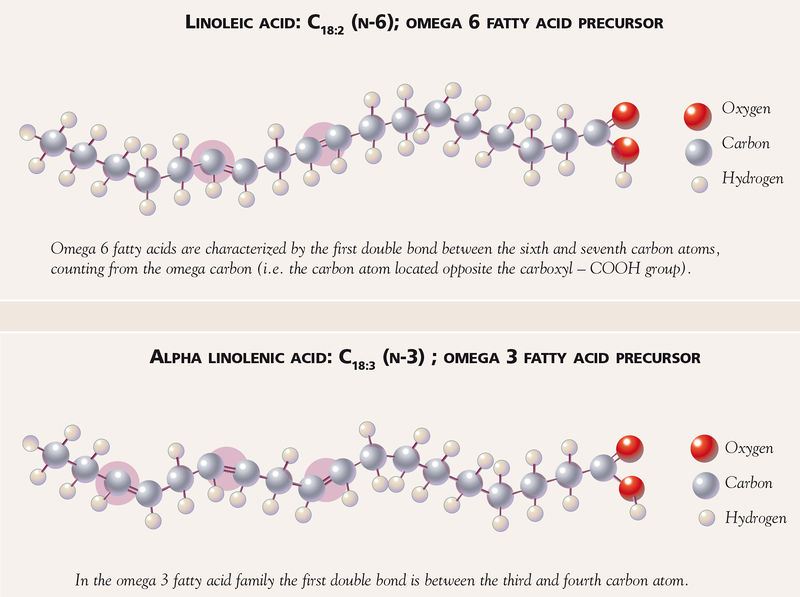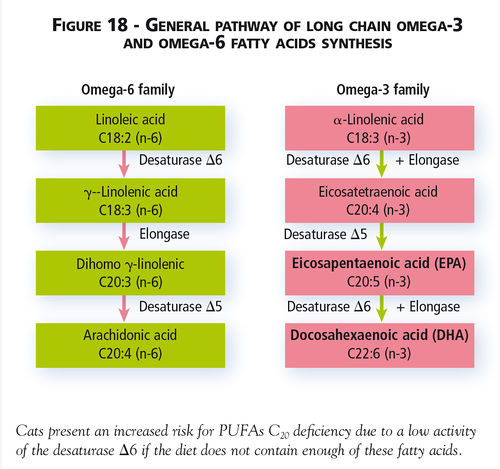Difference between revisions of "Fatty Acids Overview - Nutrition"
| (4 intermediate revisions by 2 users not shown) | |||
| Line 3: | Line 3: | ||
[[File:Canine omega3 6.jpg|800px|center|thumb|© Diffomédia/Masure]] | [[File:Canine omega3 6.jpg|800px|center|thumb|© Diffomédia/Masure]] | ||
<br><br> | <br><br> | ||
| − | Mammals are able to synthesize up to 18 carbon saturated fatty acids (i.e. stearic acid) from [[Carbohydrates Overview - Nutrition|glucose]] and [[Amino Acids Overview - Nutrition|glucogenic amino acids]]. They are also able to insert a double bond in the 9 position using the Δ9 desaturase enzyme to form the monounsaturated fatty acid, oleic acid (18:1n9), but are unable to desaturate below that. Oleic acid and medium-chain triglycerides (MCT; fatty acids 8-12 carbons long), are | + | Mammals are able to synthesize up to 18 carbon saturated fatty acids (i.e. stearic acid) from [[Carbohydrates Overview - Nutrition|glucose]] and [[Amino Acids Overview - Nutrition|glucogenic amino acids]]. They are also able to insert a double bond in the 9 position using the Δ9 desaturase enzyme to form the monounsaturated fatty acid, oleic acid (18:1n9), but are unable to desaturate below that. Oleic acid and medium-chain triglycerides (MCT; fatty acids 8-12 carbons long), are not essential dietary nutrients. Dogs and cats like other mammals have a '''dietary requirement for certain polyunsaturated fatty acids''' within the [[Omega-3 Fatty Acids - Nutrition|omega 3]] and [[Omega-6 Fatty Acids - Nutrition|omega 6]] families. Plants have Δ9 desaturase activity as well as varying amounts of Δ12 desaturase and Δ15 desaturase activity. Species differences in plants enable them to concentrate variable amounts of the long-chain and very long chain polyunsaturated fatty acids of the omega 3 and 6 families in their seeds or fleshy fruit. |
| − | + | <br> | |
[[File:Feline omega 3 and 6.jpg|500px|center|thumb|© Diffomédia/Masure]] | [[File:Feline omega 3 and 6.jpg|500px|center|thumb|© Diffomédia/Masure]] | ||
| − | + | <br> | |
[[Omega-6 Fatty Acids - Nutrition|Omega-6]] and [[Omega-3 Fatty Acids - Nutrition|omega 3]] fatty acids of equal carbon lengths '''compete for the same enzymes structures''' throughout metabolism and mammals are unable to convert between the two families. Because of this competitive inhibition and inability to alter family grouping, the total FA content of the diet as well as the ratio of specific fatty acids (e.g. AA:EPA) must be considered when evaluating fatty acid requirements and recommendations. | [[Omega-6 Fatty Acids - Nutrition|Omega-6]] and [[Omega-3 Fatty Acids - Nutrition|omega 3]] fatty acids of equal carbon lengths '''compete for the same enzymes structures''' throughout metabolism and mammals are unable to convert between the two families. Because of this competitive inhibition and inability to alter family grouping, the total FA content of the diet as well as the ratio of specific fatty acids (e.g. AA:EPA) must be considered when evaluating fatty acid requirements and recommendations. | ||
==Further Reading== | ==Further Reading== | ||
# National Research Council (NRC) (2006) '''Fat and Fatty Acids In Nutrient Requirements for Dogs and Cats.''' ''Washington, DC: National Academies Press'' p.81-110. | # National Research Council (NRC) (2006) '''Fat and Fatty Acids In Nutrient Requirements for Dogs and Cats.''' ''Washington, DC: National Academies Press'' p.81-110. | ||
| − | # Spector AA. (2000) '''Lipid metabolism: essential fatty acids. In Biochemical and Physiologic Principles of Human Nutrition.''' First edition.'' Philadelphia, PA: WB Sunders ''p373. | + | #Spector AA. (2000) '''Lipid metabolism: essential fatty acids. In Biochemical and Physiologic Principles of Human Nutrition.''' First edition.'' Philadelphia, PA: WB Sunders ''p373. |
| − | |||
| − | |||
| − | |||
| − | |||
| − | |||
[[Category:Fatty Acids]] | [[Category:Fatty Acids]] | ||
| + | [[Category:To Do - Nutrition]] | ||
| + | [[Category:To Do - Nutrition GGP]] | ||
Revision as of 09:48, 15 May 2015
Fatty acids are carboxylic acids with long hydrocarbon chains. The relative length of the hydrocarbon chain is used to designate the fatty acid as short (fewer than 6 carbons), medium (6 to 12 carbons), long (13 to 21 carbons) or very long (22 or more carbons) chain. Fatty acids can be saturated or unsaturated, with unsaturated fatty acids have one or more double bonds between carbon atoms in the hydrocarbon chain. There are several different systems of nomenclature for fatty acids, of which the delta ("Δ") and omega ("ω" or "n") systems designate the position of double bonds in the carbon chain counting from the carboxylic acid or the methyl end of the fatty acid, respectively.
Mammals are able to synthesize up to 18 carbon saturated fatty acids (i.e. stearic acid) from glucose and glucogenic amino acids. They are also able to insert a double bond in the 9 position using the Δ9 desaturase enzyme to form the monounsaturated fatty acid, oleic acid (18:1n9), but are unable to desaturate below that. Oleic acid and medium-chain triglycerides (MCT; fatty acids 8-12 carbons long), are not essential dietary nutrients. Dogs and cats like other mammals have a dietary requirement for certain polyunsaturated fatty acids within the omega 3 and omega 6 families. Plants have Δ9 desaturase activity as well as varying amounts of Δ12 desaturase and Δ15 desaturase activity. Species differences in plants enable them to concentrate variable amounts of the long-chain and very long chain polyunsaturated fatty acids of the omega 3 and 6 families in their seeds or fleshy fruit.
Omega-6 and omega 3 fatty acids of equal carbon lengths compete for the same enzymes structures throughout metabolism and mammals are unable to convert between the two families. Because of this competitive inhibition and inability to alter family grouping, the total FA content of the diet as well as the ratio of specific fatty acids (e.g. AA:EPA) must be considered when evaluating fatty acid requirements and recommendations.
Further Reading
- National Research Council (NRC) (2006) Fat and Fatty Acids In Nutrient Requirements for Dogs and Cats. Washington, DC: National Academies Press p.81-110.
- Spector AA. (2000) Lipid metabolism: essential fatty acids. In Biochemical and Physiologic Principles of Human Nutrition. First edition. Philadelphia, PA: WB Sunders p373.

